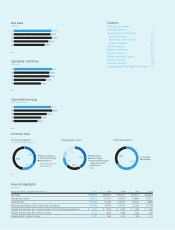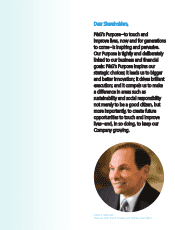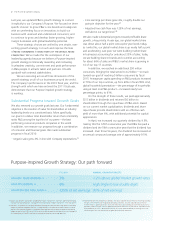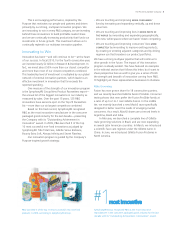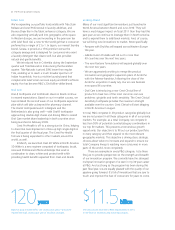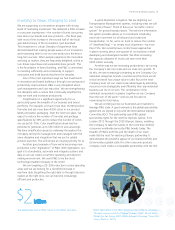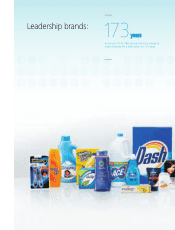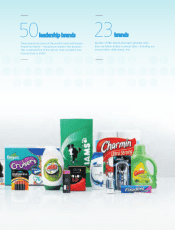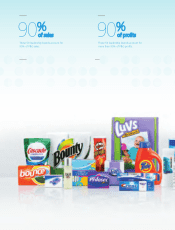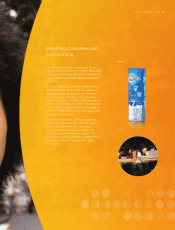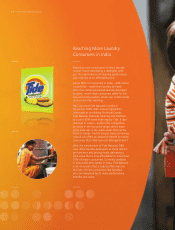Proctor and Gamble 2010 Annual Report Download - page 7
Download and view the complete annual report
Please find page 7 of the 2010 Proctor and Gamble annual report below. You can navigate through the pages in the report by either clicking on the pages listed below, or by using the keyword search tool below to find specific information within the annual report.
Investing to Grow, Changing to Lead
We are supporting our innovation program with strong
levels of marketing investment. We delivered a 20% increase
in consumer impressions—the number of times consumers
hear about our brands and new products—this fiscal year,
with most of the increase in the second half of the fiscal
year behind many of the innovations I just described.
This investment is critical. Decades of experience have
demonstrated that making people aware of our innovation
and motivating them to try our new products is the key to
long-term success. When people experience the innovation
we bring to market, they are frequently delighted, which in
turn drives repurchase and sustainable share growth. This
is the foundation of brand building, and P&G is committed
to investing sufficiently and consistently to support
innovation and build brands that thrive for decades.
One of the most important ways we fuel investments
in innovation and brand building is through cost savings and
productivity improvements. P&G is very disciplined about
cash management and cost reduction. We are strengthening
this discipline with a culture that continually simplifies the
way we work and increases productivity.
Simplification is a significant opportunity for us,
particularly given the breadth of our business and brand
portfolios. For example, we have more than 16,000 product
formulas and use more than 4,000 colors in our product
labels and plastic packaging. Over the next two years, we
expect to reduce the number of formulas and package
specifications by 30% and to reduce the number of colors
we use by 50–75%. Color simplification alone has the
potential to generate up to $50 million in annual savings.
We have simplification projects underway throughout the
Company, led by line management and managed with the
same discipline and integration that we use for global
product launches. This will remain an ongoing priority for us.
Another good example of how we’re becoming more
productive is the “digitization” of P&G. With digitization, our
goal is to standardize, automate and integrate systems and
data so we can create a real-time operating and decision-
making environment. We want P&G to be the most
technology-enabled company in the world.
We are targeting a 20–25% reduction in some spending
areas and we are looking for a sevenfold increase in
real-time data. By getting the right data to the right decision
makers at the right time, we can become increasingly
efficient and productive.
A good illustration is logistics. We are digitizing our
Transportation Management systems, including what we call
our “Control Tower.” Think of this as an “air traffic control
system” for ground transportation. The real-time information
this system provides allows us to coordinate scheduling
and truck movement for all inbound and outbound
transportation. So far, we’re on track to reduce the number
of “deadhead legs”—or, empty truck shipments—by more
than 15%. We currently have control tower approaches
in place covering about one-quarter of our business in both
developing and developed markets. We think increasing
the capacity utilization of trucks can save more than
$200 million annually.
Another way we are increasing productivity is by turning
the Company’s size into scale and our scale into growth. To
do this, we are increasingly competing as one Company. Our
individual categories, brands, countries and functions are all
critical and each has unique value to add. But at the total-
Company level, we can create scale advantages by allocating
resources more strategically and efficiently than any individual
business can do on its own. The combination of the
individual components is greater together as one Company
than the sum of the parts—and we are focused on
maximizing this total value.
We are working across our businesses and markets to
leverage P&G scale. A good example is the global sponsorship
agreement we signed in July with the International Olympic
Committee (IOC). The partnership gives P&G global
sponsorship rights for the next five Olympic Games, from
London 2012 through the 2020 Olympic Games, enabling
the Company to take the Games to the more than 4 billion
consumers worldwide served by P&G brands today. The
breadth of P&G’s portfolio and the depth of our reach
make this the most far-reaching Olympic partnership. It
demonstrates the powerful appeal of our brand portfolio and
its tremendous global scale. No other consumer products
company could create a comparable partnership with the IOC.
The approximate amount P&G invests in innovation each year.
$2 billion
The Procter & Gamble Company 5
“Never Walk Alone” from P&G's Proud Sponsor of Moms campaign—
"The best commercial of the [Olympic] Games...Gold." (Stuart Elliott,
“Medals for Ads During NBC’s Winter Olympics Coverage,” New York
Times, March 2, 2010.)


